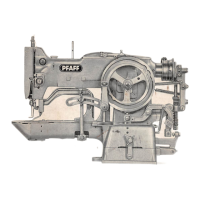b.
Timing
the Feed Motion
Timing
the feed motion is explained with the aid of o subclass -2 machine
because the adjustment procedures can best be demonstrated here. These
procedures apply to other subclasses accordingly.
(1}
Synchronizing the Feed Motion with the Needle Motion
The feed motion normally must not begin
until
the needle has risen clear of
the fabric, and must be completed when the needle enters the materiel
again. When extra-thick materials are being sewn, the observation of this
rule may prove impossible because the needle does not remain outside the
fabric
long
enough.
In
such
cases,
set the
machine
so that it
starts
feeding
shortly
before
the
ascending
needle
has
risen
clear
of
the
moterial
complete
ly.
Make
sure,
however,
the feed
motion
is
completed
when
the needle
point reaches the goods again. If the feed motion continues
after
the needle
has
entered
the
material
again,
needle
breakage
is
likely
to
occur.
To
double-check
this setting, turn the
driving
pulley
by hond so that the
feed
cam
makes
one
complete
revolution
(on
machines
making
three
bartacks
per
com
revolution,
for
instance,
the needle
cycle
will
thus
be repeated
twice).
This
is the only way to ascertain that the
setting
is correct for all
motions
involved.
If
the
settings
should
differ,
use
an
intermediate
setting.
To adjust,
loosen
hexagon nut b
(Fig.
26)
and feed cam
position
stud a, and
rotate
the
feed
cam
on
its
shaft,
as
appropriate.
After
this
adjustment,
tighten
both the nutand the
stud
securely.
Fig. 26
39

